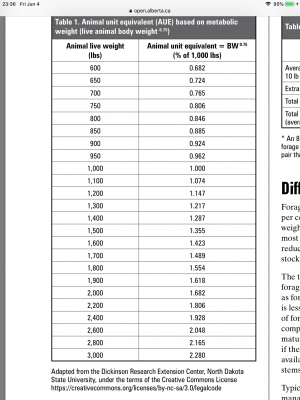All our leases are by the place or by the # of acres. Owner gets a set amount, guaranteed. If we understock, then we lose out on full utilization. If we overstock, we damage the pasture and lose out in subsequent years. Many places have been overstocked before we get them. Then it takes a couple years to get the places back to "better condition". Right now we have 2 owners complaining that there aren't enough cattle and the grass is too high and too thick. Neither place has working pens to move cattle easily in or out.... And we have been known to all of a sudden get bone dry and then they will be complaining that the cattle are damaging the grass. Yet both places we have been able to increase the carrying capacity BECAUSE we have not overstocked it and the grasses and condition of the places have gotten better.
We are getting a little tired of the constant "oversight management" of owners that won't do it for themselves, but then want to tell you how it should be done. We are most likely going to give up one place if they continue because there has been no pleasing them the last 2 years. We have extended our grazing length of time by not overgrazing, and we have been taking one cutting off the one field then allowing the cattle to graze the 2nd cutting late in the year.....there are 3 fields that are fenced off to rotate the cattle to; they now are saying that the hay should have been cut, it is past its prime, and heading out.... what difference does it make if we are feeding it to our cattle, no shares or anything.... and the 2nd growth is for the cattle to eat later on. And this place will dry up in a minute because the soil was so badly overgrazed for years, and there was so little topsoil.
On top of that, they decided they wanted to do some experimental plantings and have sectioned off part and planted switchgrass because it was touted to them as such a wonderful grass to have. The cows hate it, and these owners said oh, it is so wonderful for rotational grazing.... NO, it is not. We had the worst calf crop and growth the year we had young cows and calves in there. It is taking over the field and the cows will eat all around it and leave it. We are not going to go and constantly cut it to keep it more vegetative. I have not read anything that said it is an ideal grazing grass. It makes lousy hay, the cows will lay on it rather than eat it if they can. This section of the field is the less steep and would have been an outstanding spot to put good orchard grass/mixed seeding of hay varieties. But they know it all.
I would rather bush hog off excessive growth and build the soil tilth.... but you can't seem to make some of these people understand this. It is getting old. They want to see all these perfect pretty green fields that look like the Kentucky Bluegrass fields where they run horses.... but these hills and rock piles, just aren't going to look that way. And then when you get the places looking better, someone comes along and offers more money and you lose a place you have worked to build up and improve.
There is no sense in cutting hay when the forecast is 30-50% chance rain for the next 5 days. Son should have gotten a little sooner start when we had a window, but then we are dealing with not getting parts for a baler that a bearing has started to go bad. No sense in it, wrong parts twice from a dealer, son is trying another place.... and then the difficulty in getting parts in general.
Sorry, I got off on a tangent. One of the reasons we will not lease a place by the cow #'s. I would say that a place is worth xx dollars, and that I would agree to a maximum number of cattle to protect the land.... but that the owner should be able to count on xx dollars for the lease for the land. Period.


